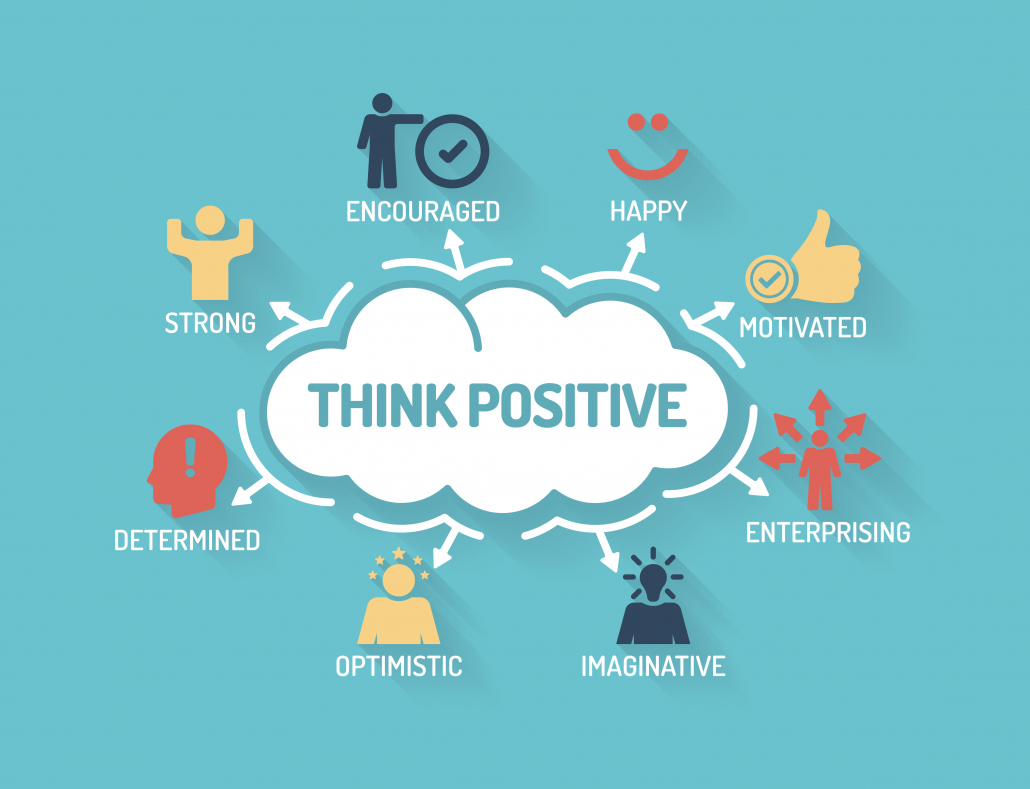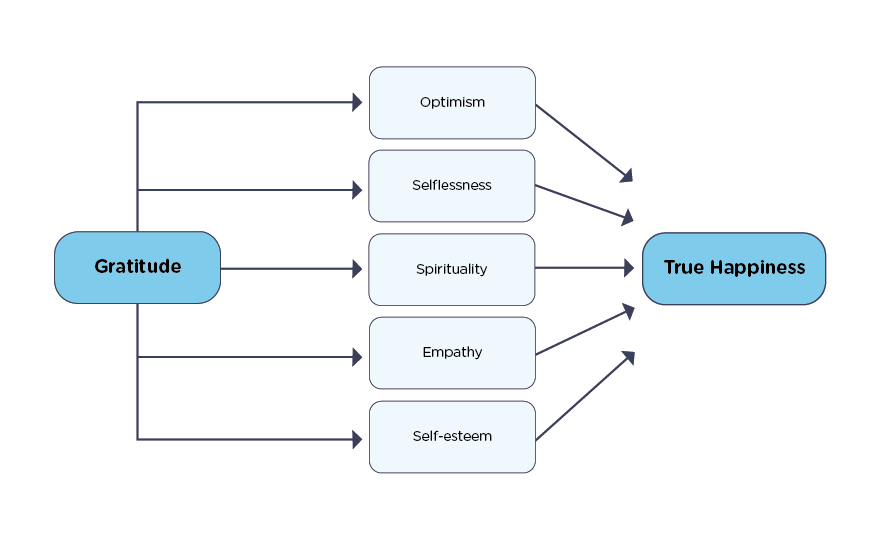We include products in articles we think are useful for our readers. If you buy products or services through links on our website, we may earn a small commission.
Positive Thinking: Benefits, Quotes, and Techniques

Positive thinking is a powerful skill for transforming your life that you can cultivate with practice.
Though it is important to be able to see the glass as half-empty and half-full, we live in very challenging times, and many of us fixate on the half-empty.
Practicing positive thinking is a way to rebalance our outlook on life, repair our self-esteem, and change maladaptive beliefs that limit our joy and affect our health.
Positive thinking can have a powerful impact, not just on our emotions but on our bodies. This makes sense from the perspective of mind-body medicine, which considers the powerful interrelationship between perceptions, emotions, behaviors, and our physical health [1][2].
Let’s explore the benefits of positive thinking, techniques for how to do it, and quotes from prominent positive thinkers to inspire you along the way.
Table of Contents
Benefits of Positive Thinking

Science is catching up with the benefits of using our minds to heal and support our overall wellbeing.
A 2017 large-scale study that followed 70,000 women from 2004 to 2012 found that those who were optimistic were significantly less likely to dye from various causes of death, including [3]:
- heart disease
- stroke
- Various cancers, including breast, lung, ovarian, colorectal
- respiratory diseases
- infection
In addition to reducing the risk of death by major causes, positive thinking is associated with other markers of wellbeing, including [4][5][6][7]:
- A higher quality of life
- More energy
- Better mental health and lower rates of depression
- faster recovery from injury
- Less stress and worry
- Fewer colds
- longer life span
Researchers haven’t pinpointed exactly why positive thinking may offer so many benefits. However, a general theory is that more positive people have less stress and therefore more protection against inflammatory damage caused by stress.
Another theorized factor is that positive thinking is linked with hope, which can motivate people to focus on long-term goals and make health and life choices to reach those goals. Studies also find that negative emotions can weaken immune response [8].
The Science of Positive Thinking
Here’s a rundown of some of the most illuminating studies exploring the power of positive thinking.
A Stanford University study found that a positive attitude towards math was linked to greater achievement in the subject. Researchers discovered that thinking more positively resulted in improved functioning in the brain’s memory center [9].
In a study exploring the links between positive thinking and creativity, researchers found that participants who were rated as happier after watching an uplifting video and listening to upbeat music were better at learning and applying a rule for classifying patterns. In this case, the video was of a laughing baby, and the music was a peppy Mozart piece.
The researchers concluded, “Generally, positive mood has been found to enhance creative problem solving and flexible yet careful thinking,”
They also suggest that watching funny videos at work is actually a way that people are getting themselves into a positive mood that can enhance performance [10]
Researchers at Washington University found that positive thoughts helped exercisers stick with their workout routines. Participants who believed in the benefits of their exercise routines were more likely to maintain them. This study shows the link between so-called manifestational thinking about real-world outcomes. There are certain things that when we believe in them we do them, making it more likely we will get the results we hope for [11].
Researchers at the University of Alberta found a significantly positive link between positive thinking and injury recovery. Among patients who suffered whiplash, those who held positive expectations recovered 300% faster. Participants with lower expectations were significantly more likely to experience symptoms six months later [12].
A study by The Association for Psychological Science a positive outlook on life predicted less memory decline with age. The researchers concluded that “individuals with higher levels of positive affect (enthusiasm and cheerfulness) had a less steep memory decline over the course of almost a decade” [13].
Positive Thinking vs. Negativity Bias
Practicing positive thinking can be a way to correct and rebalance our inherent negativity bias.
After dealing with millions of years of threats in ancestral environments, humans have evolved to be hyper-aware of negative (i.e. threatening) experiences [14].
This shows up in our everyday life when we spend time on social media or watching the news. Media agencies know that negative posts and stories get 200% more engagements and shares than positive posts and stories [15].
In a model where your attention is the currency, these media agencies will feed you an endless scroll of negative content. The more negatively emotionally activated you are, the harder it is to look away and the more people you’ll tell about your feelings.
Practicing positive thinking is a way to declutter your mind from this barrage of negative media and recalibrate your views of yourself and the world. Though there are still threats out there, most people are much safer than they believe.
As Harvard psychology professor Steven Pinker shows through extensive statistical analysis, the world is safer and people are healthier now than at any point in human history [16].
In his analysis, over the centuries human life has actually become much more positive. Now it’s time for out thinking to catch up with reality.
Can there be too Much Positive Thinking?
Even when considering humans’ negativity bias and how it is manipulated by media, it is important to consider that not all negative thinking is detrimental, and not all positive thinking is beneficial.
Studies show that some forms of negative thinking can improve performance. Some amount of self-criticism may positively affect cognitive performance by inducing a less confident state that increases internal motivation and attention [14].
Research shows that people that worry from time to time have better job performance than co-workers who never worry [15]. Having an overly positive outlook can actually reduce the accuracy of your perspective in ways that inhibit performance.
A dash of pessimism helps us prepare and appropriately react when things go wrong–which they always inevitably do to some extent [16].
The drawbacks of too much positive thinking are evident in studies showing that the new ventures of highly optimistic entrepreneurs grow more slowly and bring in less revenue [17].
While highly optimistic CEOs take on more risky debt and make decisions that expose their businesses to more risk [18][19]. In capitalism, profits reward risk, so this isn’t necessarily a bad thing, but it is a factor to consider and at least a reason for optimistic CEOs to surround themselves with pessimistic CFOs [20].
The takeaway is that some negative and pessimistic thinking is normal, natural, and beneficial.
Some people are just intrinsically prone to think more pessimistically, and that’s fine too.
A combination of genetics and developmental experiences can make either negative or positive self-talk (our constant internal monologue) dominant. The goal here is not to rip one type out and replace it with the other, but to bring more positive self-talk into your thinking system.
Too much pessimism is fatalistic and impedes growth and joy [21]. While too much positivity can be toxic and delusional.
Organizational psychologist Adam Grant sums it up, “we need the glass to be half-full and half-empty.”
So think of practicing positive thinking as a way to rebalance our inherent negativity bias towards a more positive outlook that more accurately represents reality, not to override it completely.
Techniques for Positive Thinking?
There are many ways to practice positive thinking. You might click more naturally with some of these techniques than others. If one doesn’t work give another a try. And remember that positive thinking is like a muscle, it takes time to build it and requires maintenance over time.
Smile!
The simplest technique for kickstarting your positive thinking is simply to turn that frown upside down.
A 2012 study from the University of Kansas study found that smiling—even when you’re faking it!–reduces heart rate and blood pressure during stressful situations [22].
Laugh
Studies reveal that laughter reduces stress, anxiety, and depression. Laughter has also been found to improve coping skills, mood and increase self-esteem [23].
Often laughter is a natural response to difficult situations that people repress. Give yourself permission to laugh. And, as with smiling, pretending or forcing yourself to laugh can elevate your mood and reduce stress levels.
If you’re someone who can’t bear faking it, look at some cat videos on instagram or youtube. This is one instance when spending time online can be good for your mental health.
Practice Positive Self-Talk
Self talk is our ongoing internal monologue. For many people its a litany of shame and guilt. But you can change it!
Research reveals that even small changes to how we talk to ourselves can have major benefits. Positive self-talk can help you regulate your emotions and promote adaptive behavior under stress [24].
An example of shifting to more positive self-talk looks like this:
Negative: There’s no way in hell this is going to work.
Positive: The best I can do is give this my best shot; at the very least, I’ll learn a thing or two.
Set Daily Intentions
Daily intentions are statements we make to ourselves that help us focus on positive and growthful aspects of our life. They are like micro-goals that we can achieve numerous times throughout each day.
Examples of daily intentions can be:
- Feel and express gratitude to strangers
- Lead by example
- Take rest seriously
Practice Gratitude
Practicing gratitude is a way to stimulate our innate sense of gratefulness and appreciation. It’s a two-step process: (1)“recognizing that one has obtained a positive outcome” and (2) “recognizing that there is an external source for this positive outcome.”
Start by thanking someone who has done something or you, your dog for loving you, a co-worker for being helpful. It’s simple and the results are powerful.
There are numerous ways to practice gratitude including:
- Gratitude journaling
- Meditating on the sources of happiness in your life
- Telling someone that you are grateful for something they did
- Doing something kind for someone as an expression of gratitude
- Paying mindful attention to moment-by-moment sources of pleasure like bird song, trees, art, music, and other beautiful and pleasurable things
- Giving thanks through prayer and spiritual rituals

People who regularly reflect upon and share the things they’re grateful for are rewarded with numerous benefits, including [24]:
- More optimism and a greater sense of wellbeing
- Improved immune systems
- Better sleep
- Higher self-esteem
- More numerous and satisfying relationships
Build Resiliency
Building resiliency means being able to adapt to challenging and stressful situations and losses. A few key ways to build resiliency include:
- Cultivating healthy relationships with friends, family, and peers–support groups and activity groups are great for this
- Acknowledge and accept that change and loss are part of life
- Take achievable actions when faced with problems, as opposed to hoping they resolve themselves. This doesn’t mean trying to solve something all at once, but assessing the next step right in front of you that is there to take.
Focus on the good things
Challenging situations and obstacles are a part of life. When you’re faced with one, focus on the good things no matter how small or seemingly insignificant they seem. If you look for it, you can always find the proverbial silver lining in every cloud — even if it’s not immediately obvious. For example, if someone cancels plans, focus on how it frees up time for you to catch up on a TV show or other activity you enjoy.
Spend time with positive people
Negativity and positivity are contagious. Consider the people with whom you’re spending time. Have you noticed how someone in a bad mood can bring down almost everyone in a room? A positive person has the opposite effect on others.
Being around positive people has been shown to improve self-esteem and increase your chances of reaching goals. Surround yourself with people who will lift you up and help you see the bright side.
Practice positive self-talk
We tend to be the hardest on ourselves and be our own worst critics. Over time, this can cause you to form a negative opinion of yourself that can be hard to shake. To stop this, you’ll need to be mindful of the voice in your head and respond with positive messages, also known as positive self-talk.
Identify Negative Thinking Patterns
Negative thinking patterns are pervasive. For many of us they are the default way of thinking about reality. But they can change when we identify, question them, and offer alternatives.
Common examples of negative thinking patterns include:
- Magnifying negative aspects of a situation and filtering out the positive
- Blaming yourself whenever something negative happens around you
- Believing the worst possible outcome will happen without supporting evidence
- Setting yourself up for failure by obsessing over perfection or unattainable goals
Positive Thinking Quotes
Now that you know what positive thinking is, its many benefits, and how to do it, these quotes from prominent positive thinkers can support and inspire you on your journey.
“you can, you should, and if you’re brave enough to start, you will.”
― Stephen King
“If you say you can or you can’t, you are right either way.”
–Henry Ford
“A man sees in the world what he carries in his heart.”
–Johann Wolfgang von Goethe
“Believe that life is worth living and your belief will help create the fact.”
–William James
“Hope for love, pray for love, wish for love, dream for love…but don’t put your life on hold waiting for love.”
― Mandy Hale
“The positive thinker sees the invisible, feels the intangible, and achieves the impossible.”
– Winston Churchill
“Keep my word positive. Words become my behaviors. Keep my behaviors positive. Behaviors become my habits. Keep my habits positive. Habits become my values. Keep my values positive. Values become my destiny.”
–Mahatma Gandhi, spiritual and political revolutionary
“In order to carry a positive action, we must develop here a positive vision.”
–Dalai Lama
“If you have a positive attitude and constantly strive to give your best effort, eventually you will overcome your immediate problems and find you are ready for greater challenges.”
–Pat Riley, multiple world champion NBA coach
“A positive attitude causes a chain reaction of positive thoughts, events and outcomes. It is a catalyst and it sparks extraordinary results” – Wade Boggs
“The happiness of your life depends upon the quality of your thoughts: therefore, guard accordingly, and take care that you entertain no notions unsuitable to virtue and reasonable nature.”
–Marcus Aurelius
“We are what our thoughts have made us; so take care about what you think. Words are secondary. Thoughts live; they travel far”
–Swami Vivekananda
“The most common way people give up their power is by thinking they don’t have any.”
–Alice Walker
Positive Thinking: The Takeaway
Positive thinking means having an optimistic and hopeful outlook on life. Practicing positive thinking has been shown to offer numerous physical, mental, and material benefits.
Yet, many people are addled by negative thinking patterns that impede joy, healthy relationships, and accomplishments. The good news is that there are many positive thinking techniques that nearly everyone can practice.
When making the transition to more positive thinking, it is important to let go of judgment about our negative thinking. It may be helpful to recognize that humans have an inherent negativity bias resulting from our evolution in threatening environments. Negative thinking is a way of being attuned to threats. But for most of us, this negative attunement is imbalanced and outdated.
You can practice positive thinking by tracking negative thinking patterns and cultivating positive thinking through simple practices like gratitude, smiling and laughing, and setting daily intentions.















